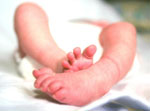Designer Babies?
BBC News
How is a 'designer baby' created?
-
 An embryo is created by in-vitro fertilization
(IVF)
An embryo is created by in-vitro fertilization
(IVF) - A single cell is removed from that embryo within the first 5 days of its creation
- The cell is genetically tested
- The parents decide whether to discard the embryo or implant it in the mother's womb
This genetic selection of embryos is called pre-implantation genetic diagnosis (PGD). There are a number of reasons parents may choose to select an embryo in this way:
- To screen for diseases such as Huntingdon's disease and cystic fibrosis or genetic conditions such as Down's syndrome
- To create a healthy baby to treat a sick sibling
- To select the sex of a future child (this is
illegal in the UK)
Case study
In 2002, a British couple, Michelle and Jayson Whitaker, sought permission from the Human Fertilisation and Embryology Authority (HFEA) to genetically select an embryo which would be a near perfect match to their four year old son Charlie who had a life threatening blood disorder.
The HFEA refused permission (although the UK's
fertility watchdog has since relaxed its rules on the procedure) and the
Whitakers went to America for IVF treatment.
Ethical problems
It sounds a brilliant way of saving a child's life, doesn't it?
Not everyone agrees - many people say that this process is unethical, and the
start of a slippery slope that leads to human cloning.
One problem can be dismissed at once is the worry
that the new baby will be subject to hurtful medical procedures; it won't. The
cells required are taken from the umbilical cord, and nothing is done to the
baby itself.
It treats the new baby as a commodity
The question to be asked is "Is this a wanted child or is it a child that's only being made to be a donor to its older brother?" If it was the latter, then the baby would be being treated as a commodity.
To see how wrong that would be let's invent an extreme case: If a child was being created just to provide a cure and was going to be sent off for adoption after the treatment was complete, that would clearly be very wrong.
But in this case the child is clearly going to be a much loved member of the family. The new baby will be loved for its own sake, and the special techniques being used are being used to bring additional benefits from the birth.
If the new baby can't provide suitable cells for the treatment the parents will be disappointed that there won't be a cure, they won't be disappointed in their new child.
So in this case (and in any case that would get HFEA permission) there is no risk of the baby being seen as a commodity.
And consider this too: Parents often have mixed
motives for having a child - maybe they want to provide company for an
existing child, or to improve their own relationship, or satisfy the in-laws,
and while we might raise an eyebrow we wouldn't say that their action was
morally wrong.
It's murder
Most people who oppose abortion do so because it involves, in their view, killing a person. They believe that this technique too inevitably kills people and that this outweighs any benefits there might be.
During the process a number of embryos will be tested to see if they are suitable.
Some embryos will be not be suitable. They will be disposed of.
Pro-life people believe that human life begins the moment the sperm fertilises the egg. This means that every unsuitable embryo that is disposed of is a person who is killed.
To put it in an extreme way: each fertilised embryo will be assessed by the scientists. It will only be allowed to live if it is a good match; if it is a bad match it will be denied its right to life.
If you believe that life begins at conception, then this argument is conclusive, and the technique is morally wrong.
If you don't believe that life begins at
conception then this argument has no weight and you can move on to look at
other arguments.
It's a slippery slope
Next stop real designer babies - chosen for eye colour or intelligence or some other parental whim.
This procedure is very expensive, and very gruelling on the parents involved. It's hard to imagine anyone willingly going through it for fun.
And even if they did, they would never get
permission from the HFEA to use the procedure frivolously.
However, this could become a worry in a country where regulation of such
techniques is less rigorous.
Designer babies approved to wipe out disease
In 2005 scientists were given approval to carry out experiments that could, within a few years lead to the first genetically altered babies being born in Britain. The controversial decision to approve this radical form of gene transplant would be the first realistic hope of an effective treatment for an entire class of serious genetic diseases.
A team at the University of Newcastle hope to combine IVF with cell and genetic surgery to wipe out diseases caused by the equivalent of faulty batteries in cells, including muscular dystrophy. The researchers will transfer cells from an embryo made by a man and woman into a fertilised egg from another woman. The embryo will have DNA from both mothers but genetic material from only one man. Although not technically cloning a human, the team has been accused of using 'cloning techniques'.
